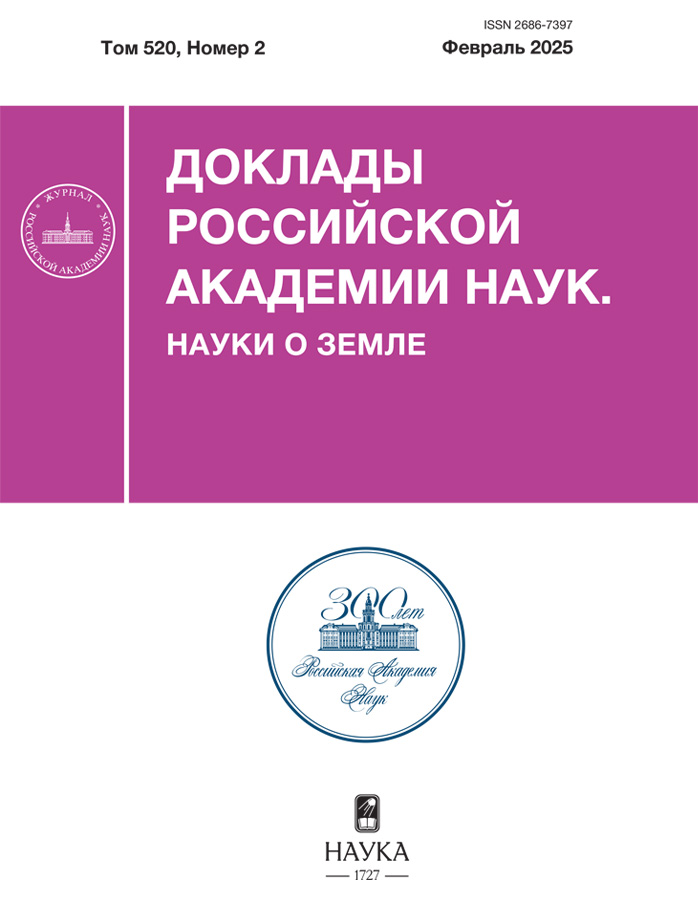Potential hazard of radioactive contamination of the marine environment due to possible earthquakes near the Kashiwazaki-Kariwa nuclear power plant
- 作者: Budyansky M.V.1,2, Uleysky M.Y.2, Lebedeva M.A.1,2, Fayman P.A.2, Belonenko T.V.1
-
隶属关系:
- Saint Petersburg State University
- Il’ichev Pacific Oceanological Institute
- 期: 卷 520, 编号 2 (2025)
- 页面: 348-358
- 栏目: GEOECOLOGY
- ##submission.dateSubmitted##: 19.06.2025
- ##submission.dateAccepted##: 19.06.2025
- ##submission.datePublished##: 19.06.2025
- URL: https://permmedjournal.ru/2686-7397/article/view/685372
- DOI: https://doi.org/10.31857/S2686739725020204
- EDN: https://elibrary.ru/GCBCIQ
- ID: 685372
如何引用文章
详细
Based on geostrophic current fields calculated from altimetry data for the period from January 1, 2013, to December 31, 2023, numerical modeling of the advection of potentially contaminated water from the Kashiwazaki-Kariwa Nuclear Power Plant to the shores of Primorsky Krai and the fishing zone around Southern Kuril Islands was carried out using a Lagrangian approach. Dasymetric maps representing probable pathways of surface ocean contamination were constructed. For the southern Primorye region, transport pathways and three corridors related to the local current structures and mesoscale eddies were identified. The minimum advection time for Lagrangian markers simulating potentially contaminated waters to reach the Primorsky Krai coast is 138–140 days. Two possible transport routes into the Southern Kuril fishing zone were revealed, with the potential for rapid advection of contaminated markers into this zone within 58–60 days. It was demonstrated that the advection of Lagrangian markers occurs in portions and within specific time windows.
全文:
作者简介
M. Budyansky
Saint Petersburg State University; Il’ichev Pacific Oceanological Institute
编辑信件的主要联系方式.
Email: plaztic@poi.dvo.ru
俄罗斯联邦, Saint Petersburg; Vladivostok
M. Uleysky
Il’ichev Pacific Oceanological Institute
Email: plaztic@mail.ru
俄罗斯联邦, Vladivostok
M. Lebedeva
Saint Petersburg State University; Il’ichev Pacific Oceanological Institute
Email: plaztic@poi.dvo.ru
俄罗斯联邦, Saint Petersburg; Vladivostok
P. Fayman
Il’ichev Pacific Oceanological Institute
Email: plaztic@poi.dvo.ru
俄罗斯联邦, Vladivostok
T. Belonenko
Saint Petersburg State University
Email: plaztic@mail.ru
俄罗斯联邦, Saint Petersburg
参考
- Арутюнян Р.В., Большов Л.А., Боровой А.А., Велихов Е.П. Системный анализ причин и последствий аварии на АЭС “Фукусима-1”. Москва: Институт проблем безопасного развития атомной энергетики РАН. 2018. 408 с. ISBN 978-5-9907220-5-7.
- Nishikawa T., Inoue H., Motohashi S., Ebisawa K. Lessons Learned from Kashiwazaki-Kariwa NPP after Niigataken Chuetsu-Oki Earthquake (2007) in View of SSI Effect / In Infra-structure Systems for Nuclear Energy (eds T.T.C. Hsu, C.-L. Wu and J.-L. Li). 2014. https://doi.org/10.1002/9781118536254.ch16
- Юрасов Г.И., Яричин В.Г. Течения Японского моря, Владивосток, 1991. С. 156–165.
- Yabe I., Kawaguchi Y., Wagawa T. et al. Anatomical study of Tsushima warm current system: determination of principal pathways and its variation // Prog. Oceanogr. 2021. V. 194. P. 102590. https://doi.org/10.1016/j.pocean.2021.102590
- Fukudome K.-I., Yoon J.-H., Ostrovskii A., Takikawa T., Han In-S. Seasonal volume transport variation in the Tsushima Warm Current through the Tsushima Straits from 10 years of ADCP observations // Journal of Oceanography. 2010. V. 66(4). P. 539–551. https://doi.org/10.1007/s10872-010-0045-5
- Shin H.-R., Lee J.-H., Kim C.-H., Yoon J.-H., Hirose N., Takikawa T., Cho K. Long-term variation in volume transport of the Tsushima warm current estimated from ADCP current measurement and sea level differences in the Korea/Tsushima Strait // J. Mar. Syst. 2022. V. 232. P. 103750. https://doi.org/10.1016/j.jmarsys.2022.103750
- Hirose N., Ostrovskii A.G. Quasi-biennial variability in the Japan Sea // J. Geophys. Res. 2000. V. 105(C6). P. 14011–14027. https://doi.org/10.1029/2000JC900046
- Kim D., Shin H.-R., Kim C.-H., Hirose N. Characteristics of the East Sea (Japan Sea) circulation depending on surface heat flux and its effect on Branching of the Tsushima Warm Current // Continental Shelf Research. 2020. V. 192. P. 104025. https://doi.org/10.1016/j.csr.2019.104025
- Takikawa T., Watanabe T., Senjyu T., Morimoto A. Wind-driven intensification of the Tsushima Warm Current along the Japanese coast detected by sea level difference in the summer monsoon of 2013 // Continental Shelf Research. 2017. V. 143. P. 217–277. https://doi.org/10.1016/j.csr.2016.06.004
- Wagawa T., Kawaguchi Y., Igeta Y., Honda N., Okunishi T., Yabe I. Observations of oceanic fronts and water-mass properties in the central Japan Sea: Repeated surveys from an underwater glider // Journal of Marine Systems. 2019. V. 201. P. 103242. https://doi.org/10.1016/j.jmarsys.2019.103242
- Wagawa T., Igeta Y., Ikeda S., Fukudome K., Hasegawa D., Tanaka T. Variation of upper-layer flow structures and water masses observed around the Noto Peninsula and Sado Island, Japan // Continental Shelf Research. 2022. V. 255. P. 104911. https://doi.org/10.1016/j.csr.2022.104911
- Igeta Y., Yankovsky A., Fukudome K., Ikeda S., Okei N., Ayukawa K., Kaneda A., Watanabe T. Transition of the Tsushima Warm Current Path Observed over Toyama Trough, Japan // J. Phys. Oceanogr. 2017. V. 47. P. 2721–2739. https://doi.org/10.1175/JPO-D-17-0027.1
- Kaneda A., Ayukawa K., Hirose N. et al. Sudden strong current generated by an eddy in the eastern part of Wakasa Bay, Japan // J. Oceanogr. 2017. V. 73. P. 181–192. https://doi.org/10.1007/s10872-016-0395-8
- Watanabe T., Katoh O., Yamada H. Structure of the Tsushima warm current in the northeastern Japan Sea // J. Oceanogr. 2006. V. 62. P. 527–538. https://doi.org/10.1007/s10872-006-0073-3
- Kawamura H., Ito T., Hirose N., Takikawa T., Yoon J.-H. Modeling of the branches of the Tsushima Warm Current in the Eastern Japan Sea // J. Oceanogr. 2009. V. 65. P. 439–454. https://doi.org/10.1007/s10872-009-0039-3
- Дьяков Б.С. Результаты океанологического мониторинга северо-западной части Японского моря в 2018 г. // Труды ВНИРО. 2020. № 180. С. 5–22. http://dx.doi.org/10.36038/2307-3497-2020-180-5-22
- Андреев А.Г. Особенности циркуляции вод в южной части Татарского пролива // Исследование Земли из космоса. 2018. № 1. С. 3–11. http://dx.doi.org/10.7868/S0205961418010013
- Ponomarev V., Fayman P., Prants S., Budyansky M., Uleysky M. Simulation of mesoscale circulation in the Tatar Strait of the Japan Sea // Ocean Model. 2018. V. 126. P. 43–55. http://dx.doi.org/10.1016/j.ocemod.2018.04.006
- Kim T., Yoon J.-H. Seasonal variation of upper layer circulation in the northern part of the East/Japan Sea // Cont. Shelf Res. 2010. V. 30. P. 1283–1301. https://doi.org/10.1016/j.csr.2010.04.006
- Никитин А.А., Дьяков Б.С., Капшитер А.В. Приморское течение на стандартных разрезах и спутниковых изображениях Японского моря // Исследование Земли из космоса. 2020. № 1. С. 31–43. https://doi.org/10.31857/S0205961420010078
补充文件















